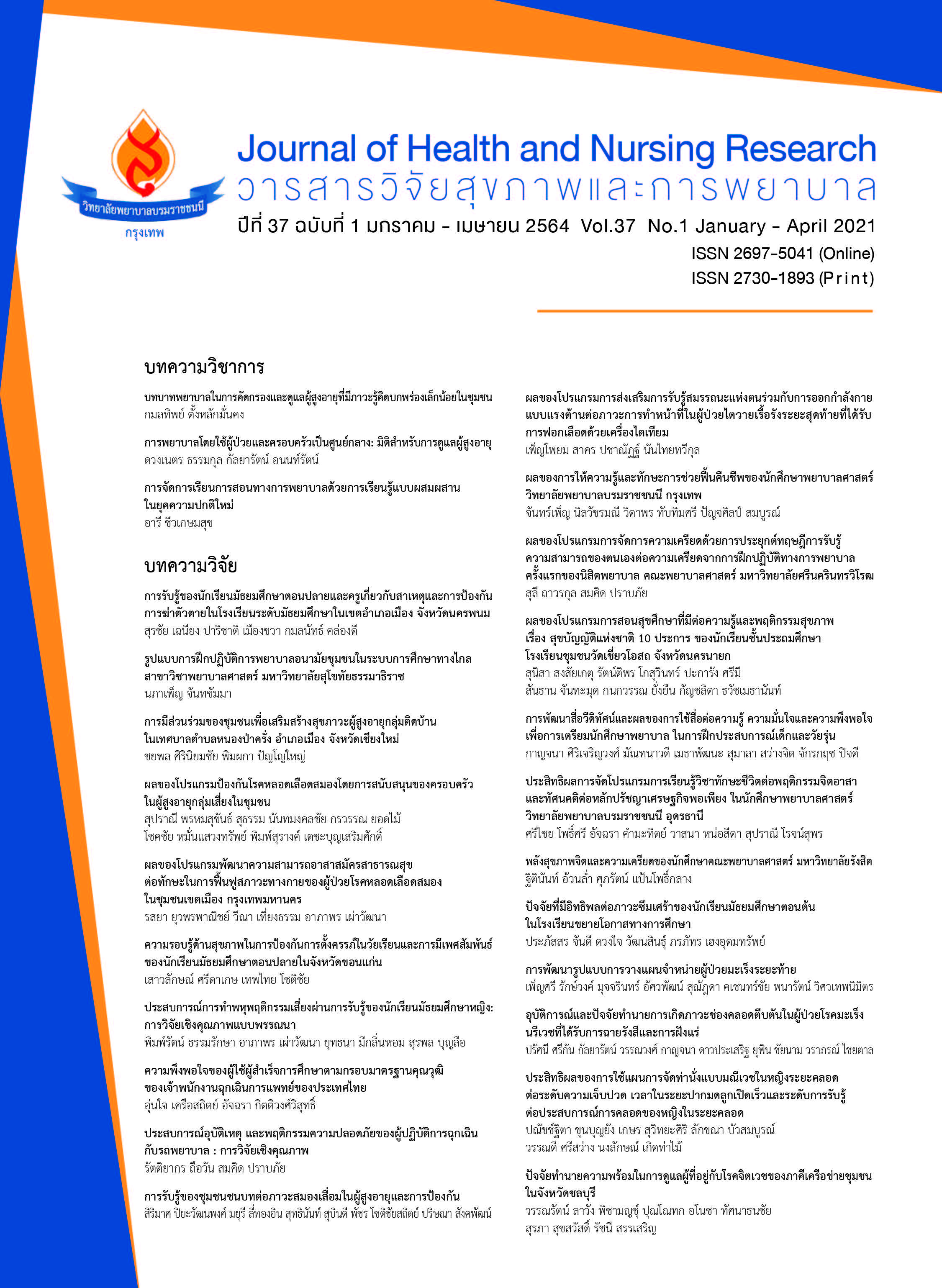ผลของโปรแกรมการส่งเสริมการรับรู้สมรรถนะแห่งตนร่วมกับการออกกำลังกายแบบแรงต้านต่อภาวะการทำหน้าที่ในผู้ป่วยไตวายเรื้อรังระยะสุดท้ายที่ได้รับ การฟอกเลือดด้วยเครื่องไตเทียม
คำสำคัญ:
ภาวะการทำหน้าที่, การรับรู้สมรรถนะแห่งตน, การออกกำลังกายแบบแรงต้าน, ผู้ป่วยไตวายเรื้อรังระยะสุดท้าย, การฟอกเลือดด้วยเครื่องไตเทียมบทคัดย่อ
บทนำ: ผู้ป่วยไตวายเรื้อรังระยะสุดท้ายที่ได้รับการฟอกเลือดด้วยเครื่องไตเทียม เป็นกลุ่มผู้ป่วยเรื้อรังที่มีแนวโน้มจะเพิ่มขึ้นทุกปี ผลกระทบหนึ่งที่สำคัญคือ ภาวะการทำหน้าที่ที่ลดลงของผู้ป่วย ดังนั้น การพัฒนาโปรแกรมการส่งเสริมการรับรู้สมรรถนะแห่งตนร่วมกับการออกกำลังกายแบบแรงต้าน เพื่อช่วยเพิ่มภาวะการทำหน้าที่ของผู้ป่วยที่ได้รับการฟอกเลือดด้วยเครื่องไตเทียม จึงมีความสำคัญอย่างมาก วัตถุประสงค์การวิจัย: เพื่อเปรียบเทียบภาวะการทำหน้าที่ของผู้ป่วยไตวายเรื้อรังที่ได้รับการฟอกเลือดด้วยเครื่องไตเทียมก่อนและหลังได้รับโปรแกรมการฯ และเปรียบเทียบภาวะการทำหน้าที่ของผู้ป่วยไตวายเรื้อรังที่ได้รับการฟอกเลือดด้วยเครื่องไตเทียมระหว่างกลุ่มที่ได้รับโปรแกรมฯกับกลุ่มที่ได้รับการพยาบาลตามปกติ ระเบียบวิธีวิจัย: เป็นการวิจัยกึ่งทดลอง แบบสองกลุ่มวัดก่อนและหลังการทดลอง เก็บข้อมูลโดยใช้ แบบสอบถามข้อมูลทั่วไป แบบประเมินคัดกรองความเหนื่อยล้า แบบประเมินภาวะการทำหน้าที่ revised Inventional Status-Dialysis (IFS-Dialysis) และแบบประเมินการรับรู้สมรรถนะแห่งตน ในผู้ป่วยไตวายเรื้อรังระยะสุดท้ายที่ได้รับการฟอกเลือดด้วยเครื่องไตเทียม กลุ่มละ 22 ราย วิเคราะห์ข้อมูลโดยใช้สถิติ Independent t-test และ Paired t-test ผลการวิจัย: พบว่า 1) ผู้ป่วยหลังได้รับโปรแกรมการส่งเสริมการรับรู้สมรรถนะแห่งตนร่วมกับการออกกำลังกายแบบแรงต้าน มีค่าคะแนนเฉลี่ยภาวะการทำหน้าที่หลังได้รับโปรแกรมฯสูงกว่าก่อนได้รับโปรแกรมฯ อย่างมีนัยสำคัญทางสถิติที่ระดับ .05 2) ผู้ป่วยหลังได้รับโปรแกรมฯ มีค่าคะแนนเฉลี่ยภาวะการทำหน้าที่สูงกว่าผู้ป่วยที่ได้รับการพยาบาลตามปกติ อย่างมีนัยสำคัญทางสถิติที่ระดับ .05 สรุปผล: ผู้ป่วยไตวายเรื้อรังที่ได้รับการฟอกเลือดด้วยเครื่องไตเทียมหลังได้รับโปรแกรมการส่งเสริมการรับรู้สมรรถนะแห่งตนร่วมกับการออกกำลังกายแบบแรงต้านมีภาวะการทำหน้าที่สูงกว่าก่อนได้รับโปรแกรมฯ และภาวะการทำหน้าที่ในกลุ่มที่ได้รับโปรแกรมฯสูงกว่ากลุ่มที่ได้รับการพยาบาลตามปกติ ข้อเสนอแนะ: ควรนำโปรแกรมไปพัฒนารูปแบบหรือประยุกต์ใช้ในการวางแผนการปฏิบัติการพยาบาลในคลินิกโรคไตหรือหน่วยไตเทียมและเป็นแนวทางในการวิจัยเกี่ยวกับการพัฒนาโปรแกรมและสื่อนวัตกรรม เพื่อส่งเสริมและพัฒนาภาวะการทำหน้าที่แก่ผู้ป่วยที่ได้รับการฟอกเลือดด้วยเครื่องไตเทียม
Downloads
เอกสารอ้างอิง
USRDS U. Annual data report: atlas of chronic kidney disease and end-stage renal disease in the United States. National Institutes of Health, National Institute of Diabetes and Digestive and Kidney Diseases. 2013.
Liyanage T, Ninomiya T, Jha V, Neal B, Patrice HM, Okpechi I, et al. Worldwide access to treatment for end stage kidney disease: a systematic review. The Lancet 2015;385(9981):1975-82.
Chuasuwan A, Lumpaopong A. Thailand Renal Replacement Therapy Year 2015. Bankok: The Nephrology Society of Thailand; 2015. 102 p.
Satirapoj B. Essential nephrology. Bangkok: Phramongkutklao Medical book Project; 2012.
Kantachuwatesiri S. Textbook of Chronic Kidney Disease. Bangkok: Text and general pulication;2017.
Mollaoglu M. Fatigue in people undergoing hemodialysis. Dialysis & Transplantation. 2009;38(6):216-20.
Gantagad T, Chuachedton P. Predicting factors in functional ability among persons with end stage renal disease receiving hemodialysis. Thai Journal of Nursing Council. 2014;29(4):92-104.
Thomas-Hawkins C. Assessing role activities of individuals receiving long-term hemodialysis: psychometric testing of the revised Inventory of Functional Status-Dialysis (IFS-DialysisR). International journal of nursing studies 2005;42(6):687-94.
Lai Y-C, Wang C-Y, Moi S-H, Wu C-H, Yang C-H, Chen J-B. Factors Associated with Functional Performance among Patients on Hemodialysis in Taiwan. Blood Purification 2018;46(1):12-8.
Liu Y-M, Chang H-J, Wang R-H, Yang L-K, Lu K-C, Hou Y-C. Role of resilience and social support in alleviating depression in patients receiving maintenance hemodialysis. Therapeutics and Clinical Risk Management 2018;14:441.
Garcia RSA, Fonseca LLM, Amaral RF, Souza BGd, Ribeiro dOGM, Sant'Ana BL, et al. Factors associated with functional capacity in hemodialysis patients. Artificial Organs 2017;41(12):1121-6.
Smith MJ, Liehr PR. Middle range theory for nursing (3rd ed.). New York: Springer; 2014.
Han HF, Chen YC, Yeh ML, Chung YC. Factors affecting physical performance status in long-term hemodialysis patients. Journal of Nursing and Health Care Research 10(3):211-9.
American College of Sports Medicine. ACSM's guidelines for exercise testing and prescription. 10 ed: Philadelphia : Wolters Kluwer; 2018.
Bennett PN, Daly RM, Fraser SF, Haines T, Barnard R, Ockerby C, et al. The impact of an exercise physiologist coordinated resistance exercise program on the physical function of people receiving hemodialysis: a stepped wedge randomised control study. BMC Nephrology 2013;14(204):1-7.
Wang XH, Mitch WE. Mechanisms of muscle wasting in chronic kidney disease. Nature reviews Nephrology 2014;10(9):504-16.
Chen JL, Godfrey S, Ng TT, Moorthi R, Liangos O, Ruthazer R, et al. Effect of intra-dialytic, low-intensity strength training on functional capacity in adult haemodialysis patients: a randomized pilot trial. Nephrology Dialysis Transplantation. 2010;25(6): 1936-43.
Kumdee K.. Effects of exercise program on quadriceps muscle strength and functional capacity among end-stage renal disease patients receiving hemodialysis. [Independent Study]: Chiangmai University; 2009.
Cohen J. Statistical Power Analysis for the Behavioral Sciences. 2 ed. 2nd, editor. New York: Routledge; 1988.
Maneesriwongul W, Dixon JK. Instrument translation process: a methods review. J Adv Nurs 2004;48(2):175-86.
Bandura A. Self-Efficacy: The Exercise of Control: Worth Publishers; 1997.
Aimsupasit S. Theories and techniques in behavior modification. 8 ed. Bankok: Chulalongkorn University Press; 2013.
Bag E, Mollaoglu M. The evaluation of self-care and self-efficacy in patients undergoing hemodialysis. J Eval Clin Pract 2010;16(3):605-10.
Tsay SL. Self-efficacy training for patients with end-stage renal disease. Journal of Advanced Nursing 2003;43(4):370-5.
Aliasgharpour M, Shomali M, Moghaddam MZ, Faghihzadeh S. Effect of a self-efficacy promotion training programme on the body weight changes in patients undergoing haemodialysis. Journal of Renal Care 2012;38(3):155-61.
Saiednejad Z, Mirbagher Ajorpaz N, Aghajani M. Application of empowerment program on self-efficacy of patients under hemodialysis: a clinical randomized controlled trial. Crit Care Nurs J 2018;11(3):e81054.
Kirkman DL, Mullins P, Junglee NA, Kumwenda M, Jibani MM, Macdonald JH. Anabolic exercise in haemodialysis patients: a randomised controlled pilot study. Journal of Cachexia, Sarcopenia and Muscle 2014;5(3):199-207.
Cheema B, Abas H, Smith B, O’Sullivan A, Chan M, Patwardhan A, et al. Randomized controlled trial of intradialytic resistance training to target muscle wasting in ESRD: the progressive exercise for anabolism in kidney disease (PEAK) study. American Journal of Kidney Diseases 2007;50(4):574-84.
Lopes LCC, Mota JF, Prestes J, Schincaglia RM, Silva DM, Queiroz NP, et al. Intradialytic resistance training iImproves functional capacity and lean mass gain in individuals on hemodialysis: a randomized pilot trial. Archives of Physical Medicine and Rehabilitation 2019;100(11):2151-8.
ดาวน์โหลด
เผยแพร่แล้ว
รูปแบบการอ้างอิง
ฉบับ
ประเภทบทความ
สัญญาอนุญาต
บทความที่ได้รับการตีพิมพ์ เป็นลิขสิทธิ์ของวารสารวิจัยสุขภาพและการพยาบาล (วิทยาลัยพยาบาลบรมราชชนนี กรุงเทพ) ไม่สามารถนำไปตีพิมพ์ซ้ำในวารสารฉบับอื่น


















